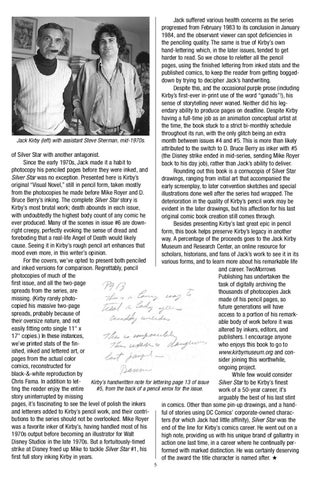Jack suffered various health concerns as the series progressed from February 1983 to its conclusion in January 1984, and the observant viewer can spot deficiencies in the penciling quality. The same is true of Kirby’s own hand-lettering which, in the later issues, tended to get harder to read. So we chose to reletter all the pencil pages, using the finished lettering from inked stats and the published comics, to keep the reader from getting boggeddown by trying to decipher Jack’s handwriting. Despite this, and the occasional purple prose (including Kirby’s first-ever in-print use of the word “gonads”!), his sense of storytelling never waned. Neither did his legendary ability to produce pages on deadline. Despite Kirby having a full-time job as an animation conceptual artist at the time, the book stuck to a strict bi-monthly schedule throughout its run, with the only glitch being an extra Jack Kirby (left) with assistant Steve Sherman, mid-1970s. month between issues #4 and #5. This is more than likely attributed to the switch to D. Bruce Berry as inker with #5 of Silver Star with another antagonist. (the Disney strike ended in mid-series, sending Mike Royer Since the early 1970s, Jack made it a habit to back to his day job), rather than Jack’s ability to deliver. photocopy his penciled pages before they were inked, and Rounding out this book is a cornucopia of Silver Star Silver Star was no exception. Presented here is Kirby’s drawings, ranging from initial art that accompanied the original “Visual Novel,” still in pencil form, taken mostly early screenplay, to later convention sketches and special from the photocopies he made before Mike Royer and D. illustrations done well after the series had wrapped. The Bruce Berry’s inking. The complete Silver Star story is deterioration in the quality of Kirby’s pencil work may be Kirby’s most brutal work; death abounds in each issue, evident in the later drawings, but his affection for his last with undoubtedly the highest body count of any comic he original comic book creation still comes through. ever produced. Many of the scenes in issue #6 are downBesides presenting Kirby’s last great epic in pencil right creepy, perfectly evoking the sense of dread and form, this book helps preserve Kirby’s legacy in another foreboding that a real-life Angel of Death would likely way. A percentage of the proceeds goes to the Jack Kirby cause. Seeing it in Kirby’s rough pencil art enhances that Museum and Research Center, an online resource for mood even more, in this writer’s opinion. scholars, historians, and fans of Jack’s work to see it in its For the covers, we’ve opted to present both penciled various forms, and to learn more about his remarkable life and inked versions for comparison. Regrettably, pencil and career. TwoMorrows photocopies of much of the Publishing has undertaken the first issue, and all the two-page task of digitally archiving the spreads from the series, are thousands of photocopies Jack missing. (Kirby rarely photomade of his pencil pages, so copied his massive two-page future generations will have spreads, probably because of access to a portion of his remarktheir oversize nature, and not able body of work before it was easily fitting onto single 11" x altered by inkers, editors, and 17" copies.) In these instances, publishers. I encourage anyone we’ve printed stats of the finwho enjoys this book to go to ished, inked and lettered art, or www.kirbymuseum.org and conpages from the actual color sider joining this worthwhile, comics, reconstructed for ongoing project. black-&-white reproduction by While few would consider Chris Fama. In addition to letKirby’s handwritten note for lettering page 13 of issue Silver Star to be Kirby’s finest #5, from the back of a pencil xerox for the issue. ting the reader enjoy the entire work of a 50-year career, it’s story uninterrupted by missing arguably the best of his last stint pages, it’s fascinating to see the level of polish the inkers in comics. Other than some pin-up drawings, and a handand letterers added to Kirby’s pencil work, and their contriful of stories using DC Comics’ corporate-owned characbutions to the series should not be overlooked. Mike Royer ters (for which Jack had little affinity), Silver Star was the was a favorite inker of Kirby’s, having handled most of his end of the line for Kirby’s comics career. He went out on a 1970s output before becoming an illustrator for Walt high note, providing us with his unique brand of gallantry in Disney Studios in the late 1970s. But a fortuitously-timed action one last time, in a career where he continually perstrike at Disney freed up Mike to tackle Silver Star #1, his formed with marked distinction. He was certainly deserving first full story inking Kirby in years. of the award the title character is named after. ★ 5
Issuu converts static files into: digital portfolios, online yearbooks, online catalogs, digital photo albums and more. Sign up and create your flipbook.
